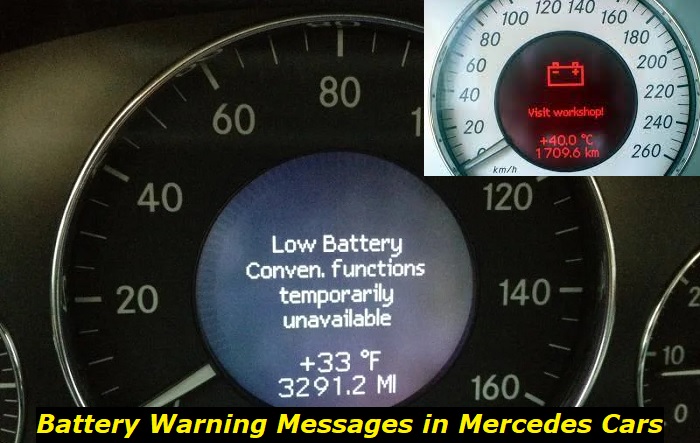I've already written an article about the "Stop Vehicle Leave Engine Running" message in your Mercedes car - you may have a look here. But today I will concentrate on the battery problems that, in most cases, cause this problem.
Battery warning lights highlights
- Common reasons:low battery, electrical gremlin
- How to fix:check the battery voltage, replace the battery
- Possible consequences:when the battery is dead, you may get stranded
- Priority level:High
- Can you drive?Yes
- DIY repair:Possible
- Repair price range:$200-$450

If you keep getting these warnings and messages pretty often, you may need to check the charging system and both batteries. Also, it's very likely that your Mercedes has a power drain somewhere in the system and it should be found by the specialist.
You may also find my other article about the auxiliary battery problems in Mercedes cars helpful. Have a look!
The reasons for battery problems in your Mercedes car
Here are the most common reasons why your battery triggers warning lights and messages in your vehicle:
- the battery is old and about to die - doesn't matter if it's about the main or auxiliary battery;
- the serpentine belt is slipping or absent - a surprisingly common issue;
- the alternator isn't charging the battery properly;
- there are problems with the cables and connections;
- the battery was sitting for a long time and needs to be boosted;
- there are issues with control modules that control the batteries and charging.
Your Mercedes is a highly electronically saturated car and it has dozens of control modules. Several of them are connected to the batteries and rely on them or control them. For example, a serious failure in the SAM module (Signal Acquisition Module) can cause battery or charging issues.
But if it's all about some electronic failure, you have just one choice - to go to the dealer and hope that the mechanic will be experienced enough to find the problem from the first inspection (which is unlikely).
You should still start with the simple checkups and fixes. Let's see what they are all about.
1) Checking the serpentine belt
The serpentine belt connects several additional units under the hood of your car to the engine and helps it rotate and function. These units are, for example, the AC compressor and the alternator. If the belt slips or is broken, your battery will not get any charge from the alternator. Or the charging will be intermittent.
If the belt slips, you will hear a squealing noise when starting the car. If it's broken, you can't locate it under the hood which is the direct sign that you've just found the problem.
To install the new belt, you should find a good mechanic. Also, make sure you change the belt once every 40,000 miles or so to avoid problems with it.
2) Checking the connections
Loose connections are pretty common for any car. If you keep getting battery warnings in your Mercedes, check if all the visible connections are good. Of course, the primary connections you should check are the main battery clamps. Take a wrench and tighten the nuts on them. If they look dirty, disconnect the battery and clean all the buildups.
Also, you may want to check the connections on the auxiliary battery and on the alternator. Maybe, you may also locate a broken cable during this process. If you do, get the car to a good mechanic for repairs.
3) Checking the batteries' health
One more thing you can do is check the batteries. While auxiliary batteries are sometimes hard to get to in modern Mercedes vehicles, main batteries are easy to check. Use the multimeter to see if the battery has 12.4-12.5 volts when the car is off. Then start the vehicle and measure the voltage again - it should be over 14 volts.
Also, if during engine startup the battery voltage drops below 12 volts, it means that the battery is pretty weak.
Unfortunately, the batteries in Mercedes cars don't live long. The average life of the 12V battery, main or auxiliary, is about three and a half years. After that, they may need recharging and after some time they should be replaced.
If you see that the battery's voltage is weak, you may need to jump or charge the battery. This will help you solve the problem for some time.
Also, if the battery is charged very fast, it means it's dead and needs to be replaced.
4) More complicated things
If the problem is with some electronic control modules or wiring, I don't recommend you deal with this on your own. Even dealership mechanics often fail to diagnose the car properly because the systems are extremely complicated.
So, no DIY methods will most likely help you locate the issue. The best solution is to go to the dealer and ask for a deep inspection to find the actual reason for the problem.
Can you drive with the battery warning message?
Yes, you can drive with this message, there is no reason for stopping the vehicle because things may get worse. Whenever you see this message, you may keep on driving till your car still can do this.
I strongly recommend keeping the engine running even if you stop. When you turn off the engine with the battery warning on the dash, you risk a lot. The engine may not start after that and you will have to pay for a tow truck.
Keep driving and find the nearest dealership to let them look at your car.
Also, remember that even batteries in your Mercedes vehicle can be replaced under warranty. I've seen hundreds of new Mercedes vehicles' owners getting free batteries from dealers. It's good because the price of a good MB battery is about $300.
If you have experience dealing with the battery warning light, the best thing you can do is to share your experience in the comments below to let other Mercedes drivers know where to look!
About the authors
The CarAraC research team is composed of seasoned auto mechanics and automotive industry professionals, including individuals with advanced degrees and certifications in their field. Our team members boast prestigious credentials, reflecting their extensive knowledge and skills. These qualifications include: IMI: Institute of the Motor Industry, ASE-Certified Master Automobile Technicians; Coventry University, Graduate of MA in Automotive Journalism; Politecnico di Torino, Italy, MS Automotive Engineering; Ss. Cyril and Methodius University in Skopje, Mechanical University in Skopje; TOC Automotive College; DHA Suffa University, Department of Mechanical Engineering






Add comment